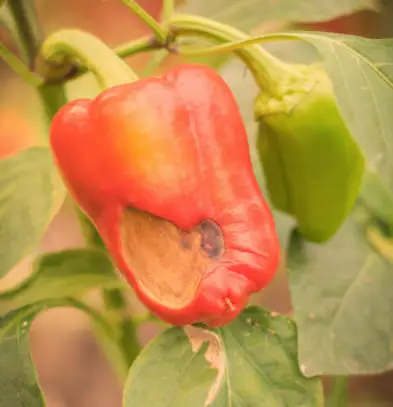Both commercial growers and home gardeners adore bell peppers as a crop. Understandably, these members of the nightshade family have become commonplace in vegetable patches and on dinner plates all around the world with their vibrant colors, crisp texture, and culinary diversity.
However, like any plant, bell peppers are susceptible to their fair share of diseases that can quickly turn a promising crop into an inedible, wilted mess.
We will look at a few of the most prevalent and dangerous illnesses that can affect bell pepper plants.
We will go over the symptoms, causes, and fixes for everything from fungal infestations to viral illnesses, so you can maintain a healthy and plentiful pepper crop. Now take a trowel and let us explore the realm of disorders related to bell peppers!
Bacterial Leaf Spot
Caused by multiple species of the Xanthomonas bacteria, bacterial leaf spot is one of the biggest bacterial disease threats to bell peppers. This disease presents as small, water-soaked lesions on the leaves that eventually turn brown or black.

Bacterial Leaf Spot
As the disease progresses, whole branches may become blighted, fruit can develop unsightly raised scabs, and defoliation can occur. Spread by wind, rain, contaminated tools and even some insects, bacterial leaf spot thrives in warm, moist conditions.
The best defense is an integrated approach using preventative copper sprays, proper sanitation to remove diseased plant material, crop rotation, and selecting resistant cultivars. Sadly, once bacterial leaf spot takes hold, there is no cure and the diseased plants must be removed to stop further spread.
Phytophthora Blight (Buckeye Rot)
Here’s a disease that strikes fear into the heart of any pepper grower. Phytophthora blight, also known as buckeye rot, is caused by the soil-borne oomycete pathogen Phytophthora capsici. This water mold infection can strike all parts of the plant—leaves, stems, roots, and fruit—making it a veritable killing machine in the pepper patch.

On the foliage, irregular black blotches and wilting appear, while rotted areas on the fruit develop large, sunken lesions that resemble a buckeye seed at maturity (hence the name). The roots may exhibit reddish-brown lesions and the plant will suddenly collapse and die. Spread by windblown rain and soil sitting on contaminated equipment, the fungus-like pathogen can persist in soil for years thanks to its hardy oospores.
Management focuses heavily on prevention by avoiding excessive moisture, improving soil drainage, applying fungicides, using phytophthora-resistant cultivars, and implementing a minimum 3-year crop rotation with non-host plants. Sadly, once plants are infected, they are unsalvageable and must be destroyed.
Verticillium Wilt
Both soil-borne fungi in the Verticillium genus are responsible for this problematic disease in bell peppers. Verticillium dahliae and V. albo-atrum colonize the plant’s vascular system, plugging up the flow of nutrients and water, resulting in wilting, stunting, yellowing, and eventual death. Often starting on one side of the plant or on individual branches, distinctive green striping may appear inside affected stems.

diseases of bell pepper plants
Long-lived microsclerotia allow the fungi to persist in soil for over a decade, making it extremely difficult to eliminate once established in a garden bed or field. Preventing introduction by sanitizing tools and equipment is key, as is planting resistant varieties. Unfortunately, once verticillium wilt takes hold in the soil reservoir, peppers should be rotated to a new, clean plot as soon as possible.
Tobacco Mosaic Virus (TMV)
Of the numerous viruses that can infect bell peppers, tobacco mosaic virus is among the most tenacious and fearsome. Spread in a myriad of ways—through seed, soil, plant sap, tools, and even the clothes of workers—TMV induces a range of foliar symptoms. Leaves exhibit mottling, crinkling, stunting, and streaking due to the virus hijacking and disrupting the plant’s cellular machinery.
Fruit are rendered inedible with degraded color, texture, and flavor. There is no cure for viruses, which can survive in plant debris and contaminated supplies for years. Management focuses on exclusion by using certified clean seed and transplants, proper sanitization, eliminating weeds that can harbor TMV, and establishing a long crop rotation of at least 2–3 years with non-susceptible plants.
Pythium Fruit Rot
While root and stem rots caused by Pythium species get plenty of infamy, Pythium fruit rot shouldn’t be overlooked either. Driven by excessive soil moisture and humidity, these damaging oomycetes produce water-soaked lesions on the surface of developing fruit. These rapidly become covered in cottony white growth before turning leathery and sunken.
Green fruit turns yellow, while red varieties take on a pale pinkish cast. Fruits in contact with contaminated soil are most vulnerable, so staking and mulching go a long way toward preventing infection. Applying fungicides, improving drainage, and avoiding overhead watering also keep the Pythiums at bay. Any affected fruits should be promptly discarded.
Powdery Mildew
It would be an oversight not to mention powdery mildew, that ubiquitous fungal pest that can overwhelm almost any type of plant. Bell peppers are no exception. Favored by moderate temperatures and high humidity, powdery mildew appears as the namesake dusty white coating along stems, leaves, and calyxes.

As the fungal hyphae deplete the plant’s resources, chlorosis and premature defoliation occur. Fruit quality also suffers when attacked by this unsightly pathogen. An integrated program of resistant cultivars, proper plant spacing, fungicide applications, avoidance of excess nitrogen, and removing contaminated debris will keep this disease in check.
These diseases merely scratch the surface of the multitude of biotic threats that bell pepper producers must contend with. From anthracnose and alternaria fruit rots to cercospora and cucumber mosaic virus, it’s a never-ending battle to keep plants vigorous and harvests bountiful. However, with knowledge of symptom identification, pathogen life cycles, and deployment of the best integrated pest management practices, bell pepper disease can be managed to reap a delicious, colorful crop.




